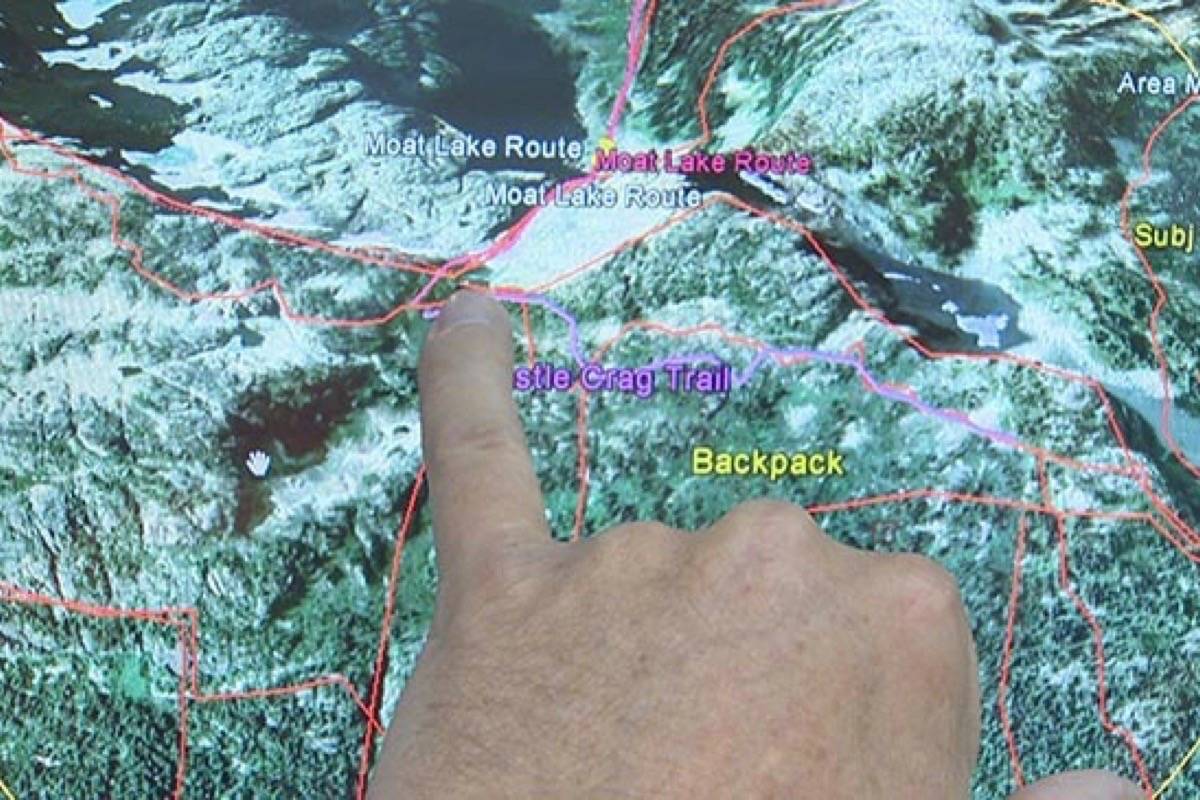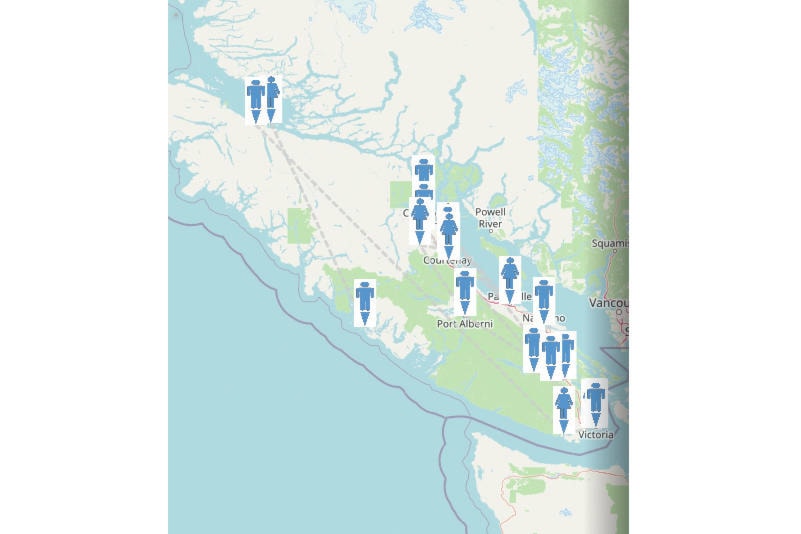Someone knows something.
That’s the hope expressed by Judy Peterson, the mother of Lindsey Nicholls, who, at the age of 14, disappeared in late July 1993 while walking along Royston Road in the Comox Valley.
“It’s unsolved and we don’t know what happened to her, and our family really needs to know,” she said in July 2018, at the 25th anniversary of her daughter’s disappearance.
“She literally vanished.”
With more than 400 tips, three excavated sites and more than 15 polygraph examinations completed by the RCMP, Peterson and her family marked the significant anniversary by placing two sets of three billboards around the Comox Valley community asking for any information.
Two years later, Nicholls is still missing.
• • •
For some families, it has been years since their loves ones were last seen on Vancouver Island; for others, it has been months.
There are more than three dozen missing people on the Island, some as recent as July, some as far back as four decades. Within the Comox Valley region, the local RCMP detachment has open investigations for people who have been missing as far back as 1978.
For those investigators working on a missing persons case, a file does not ‘go cold’ until the missing person is located, explains Const. Monika Terragni, the media relations liaison for the detachment. When tips are received, they are fully investigated until the police can locate the missing person or until they have gathered as much information as possible to move the investigation forward.
“If we are not receiving tips about open missing person investigations, we are still working with the evidence that we have and reviewing the file often. As time passes, it is common to see changes in technology, resource availability and investigative techniques and as things change, we are reviewing open files to determine if there are renewed avenues of investigation.”
She says it is common for investigators to be assigned a missing person investigation for an extended period as long as the person remains missing. This sometimes allows for an investigator to develop a more personal connection with the investigation.
“(They) are often disappointed when tips, leads do not result in locating the missing person,” Terragni says. “Each and every tip or lead is examined carefully by investigators with the ultimate goal of locating the person reported missing.”
In order to help spread information, Felicity Camp created the Vancouver Island Missing Person Facebook group about three years ago following a personal connection with a missing teen in Nanaimo. It’s the only group specifically for the Island that she knows of, and admits she finds it surprising that more pages exist for missing pets than people.
There are more than 700 members on the page, and Camp says the number of followers is growing rapidly. She has seen more than a 37 per cent jump in subscribers within the past month alone.
She explains within the last few years, the number of missing people — particularly kids — has increased dramatically.
“People don’t just disappear; someone has to know something. Some of them are just baffling.”
She hopes the page serves as a tool to amply information through social media, but admits not knowing what happened to friends and loved ones is indescribable.
“(Having the page) is better than nothing, and we’ve had nothing for a while. For the families, it’s the not knowing, and there’s no closure.”
• • •
Richard Norton was an avid hiker when he was living in Switzerland amongst the Alps and Jura mountains, and was naturally drawn to an article he found online about a fellow hiker who went missing on Mount Shasta in California in May 1999.
“He literally walked away from his two friends after an overnight camp on the mountain, walked around the corner and was never seen again … the story got my interest.”
Norton decided to set up StrangeOutdoors.com, a website to highlight what he calls are “the weirdest stories from the outdoors including strange disappearances, stories of serial killers operating in the wilderness and unexplained events relating to walking /hiking.”
He notes at the time there was no online resource that covered disappearances from the United States and beyond. He has now covered more than 100 cases in detail. The goal of the non-profit site is to keep the stories of the missing alive and offer hope to the families involved.
One of the cases Norton has followed in detail is that of missing Comox Valley hiker Sylvia Apps, who was last seen in July 2014 south on Castlecrag Mountain. Apps, who was 69 when she went missing, was an experienced hiker who began a multi-day trek from Paradise Meadows on Mount Washington.
According to the Comox Valley RCMP, she was equipped with navigation and safety equipment, and had previously made long solo treks. The Comox Valley Ground Search and Rescue, which was one of 19 different search teams from around the province that assisted with the search, found Apps’s blue backpack, containing everything except her walking poles and her camera. The items were found in a different area from where the backpack was located.
Norton characterizes the case as strange, particularly because her personal belongings were found.
“But there was no sign of her body … maybe she became disoriented, has a medical emergency and disappeared down a rock crevice … but until the body is found and identified, there will be no closure for her family.”
He says many of the disappearances he covers on his site are truly mysterious and some defy logic. Incidents such as animal attacks or getting lost can be explained through evidence, but others, he notes, are inexplicable.
“Who knows? Portals? Sasquatch? I really don’t know, but I guess the universe can be more complex than we first think. Some of the articles I have written drive me crazy trying to explain them in a way that doesn’t sound too far out.”
Many of the readers who frequent his site are hikers and those interested in mysteries, predominately from the U.S. He has been contacted by members of the families or friends missing, and Norton notes they have been very supportive as he aims to write the stories on the site in a non-sensationalist, balanced way.
“To this day, Sylvia’s remains have not been found — a baffling case,” he writes on the site.
• • •
With summer temperatures and increasing snowmelt, Michelle Root hopes those factors - and people spending more time outdoors - will assist in finding any clues to help find her husband Michael Gazetas, who went missing from the Comox Valley in January 2020.
Six months after Gazetas’s disappearance, Root asked again for assistance from the public to keep an eye out for her husband on logging roads or the backcountry for his recovery.
“It’s very important to bring him home and to get any answers we can as he left many questions about his disappearance and that we might be able to put him to rest,” she explained in June.
Gazetas, 51, was last seen Jan. 31 leaving his residence in Courtenay. Extensive searches by ground search and rescue teams, family, friends and police have been conducted but have not turned up any evidence of his whereabouts.
RCMP noted the detachment has received a lot of tips from the public, and do not have any evidence to believe he has left Vancouver Island.
One unusual tip to come forward was passed along to searchers from Tammy Lee, a ‘seer’ from the North Island who is able to have information and visions come to her. In the case of Gazetas, she actively sought them out.
“I was hoping (to get) some information from him … I’ve asked him to show me where he is but I only get (lines) crisscrossed. I figured it was a map, but I couldn’t understand where and I can’t see it clearly. Now I just get a feeling he is there but won’t talk.”
Additional specific geographical information and details about his red Ford Ranger pickup came to Lee, which was also passed along to search and rescue.
Lee understands the negative connotations attached to psychics and the idea of visions but explains the ability to see and hear spirits is something she had since she was a teen.
She has had previous experiences where she saw a series of images associated with people who were lost or missing, and their locations — once found — matched those which were told to Lee in her vision.
“I seem to only get info at night when I meditate and concentrate on the person. I’ve tried to talk to the spirits but I can’t understand them, so I ask them to send me images. Sometimes if it’s a strong connection, I can smell, taste and hear as well, but (it doesn’t happen) too often. At first, I was not able to switch it off … after that I sought out others, (an) in-town psychic.”
Understanding the skepticism about her ability to have visions, Lee hesitates to share information, particularly with the authorities. She says her own obstacles talking about them creates a problem.
“I keep thinking I can’t do this, that’s a blocker. I have to work at opening myself up, but in doing so, I see too much and it’s overwhelming.
“It’s kind of cool in a way, but the negativity behind it all keeps a lot of us behind doors. I’m only now learning to talk about.”
• • •
Decades since Lindsey Nicholls disappeared, Judy Peterson was able to celebrate a small victory.
In early 2018, following years lobbying for legislation for a national missing persons’ DNA data bank, her persistence paid off. The federal government announced a new National Missing Persons DNA Program, intended to assist missing persons and unidentified remains investigations, aptly named ‘Lindsey’s Law.’
The legislation enables police to expand the use of DNA analysis through a missing persons index, a human remains index and a relatives of missing persons index. Two new criminal indexes were also created.
“This will give me the comfort of knowing that if she is found anywhere in Canada, I would know. Also, it’s step for the investigation itself, and I feel that now I have done everything I can to help find answers.”
photos@comoxvalleyrecord.com
Like us on Facebook and follow us on Twitter




